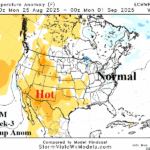
East U.S. Heat Breaks Later August But Should Regenerate in September
08/12/2025, 9:36 am EDT
Support (30-31C Water) for Category-4 Major Hurricane Erin East of Bahamas Early Next Week
08/15/2025, 6:06 am EDTClimate Impact Company Month 1-5 Outlook
South America
Issued: Thursday, August 14, 2025
Highlight: Southwest/Southeast Brazil to Argentina drought ahead.
Executive Summary: The Climate Impact Company constructed analog climate forecast valid for September 2025 through January 2026 is based on influence of climate associated with developing weak La Nina and the presence of a marine heatwave off the Argentina Coast. The outlook worsens Brazil drought except for northeast Brazil. Drought in Argentina also worsens. Avoiding drought in Paraguay. The climate outlooks indicate mostly dry conditions for Southwest/Southeast Brazil to Argentina while East/Northeast Brazil shifts wetter.
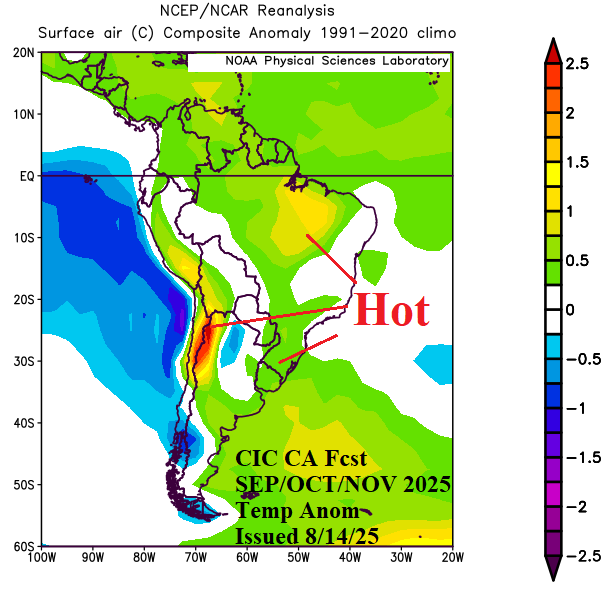
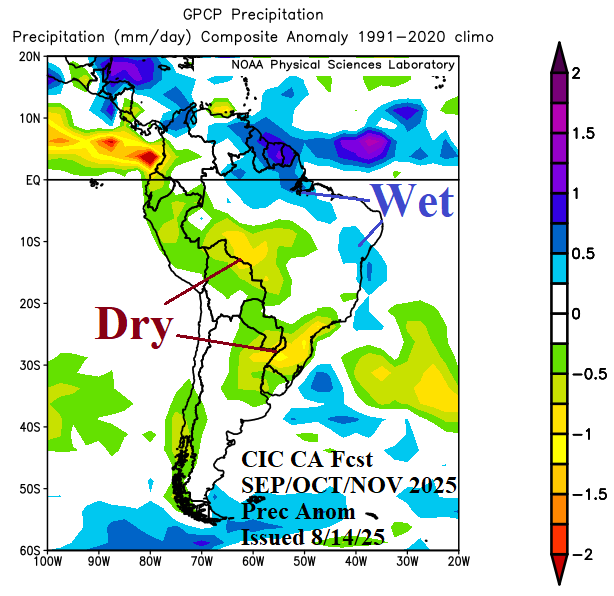
Fig. 1-2: The Climate Impact Company constructed analog temperature and precipitation forecast for SEP/OCT/NOV 2025 across South America.
Climate discussion: As meteorological winter closes, the prevailing soil moisture conditions across South America using the GRACE-based observations indicate ongoing harsh drought across central and eastern Brazil and central Argentina (Fig. 3). The NOAA/CPC daily soil moisture anomaly analysis indicates wider aerial coverage of drought in Brazil while the (drought) intensity in Central Argentina is moderate (Fig. 4). The ENSO forecast for Q4/2025 favors redeveloping weak La Nina. All forecast models except ECMWF and POAMA indicates La Nina. The key to the ENSO forecast is the observation and trend of subsurface temperature in the eastern equatorial Pacific which is steadily cooler during recent weeks (Fig. 5). A consensus forecast of all dynamic models favors the International Multi-model Ensemble (IMME) global SSTA forecast for OCT/NOV/DEC 2025 (Fig. 6) which indicates La Nina’s return with the attendant climate possibly made stronger by the presence of negative Indian Ocean dipole (-IOD). During the current decade (except 2023), presence of a strong marine heatwave (MHW) off the Argentina Coast has influenced South America climate. The IMME forecast projects a large MHW east of Argentina for Q4/2025 and maintains the semi-permanent MHW east of Australia extending toward the West Coast of South America. The upper air pattern associated with the Argentina MHW is dramatic featuring an amplified upper ridge off the South Argentina Coast and compensating weak low-pressure area off the Southeast Brazil Coast (Fig. 7). The attendant prevailing rainfall pattern for mid-spring through early summer favors dryness central continent to Northeast Argentina/Southeast Brazil while East Brazil is wet (Fig. 8). The MHW-based climate projection is heavily weighted with influence of La Nina to generate the month 1-5 ahead climate forecast.
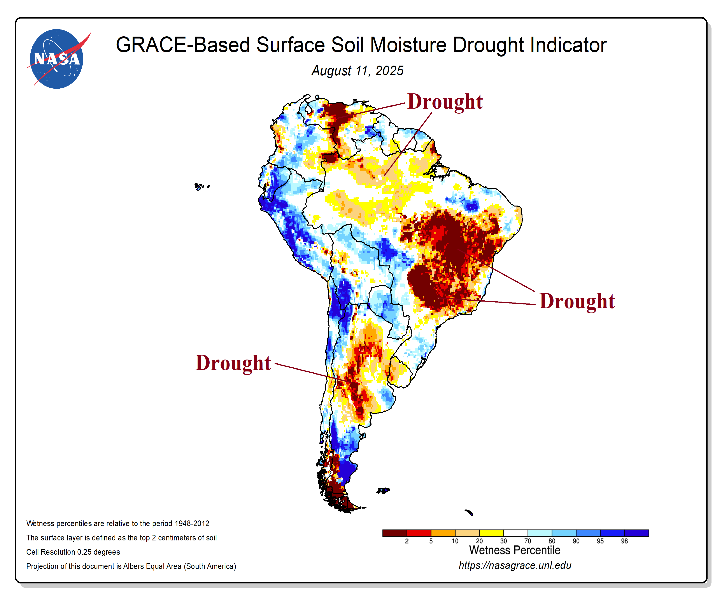

Fig. 3-4: GRACE and NOAA/CPC soil moisture anomaly analysis across South America.

Fig. 5: The subsurface equatorial Pacific upper ocean heat anomalies.
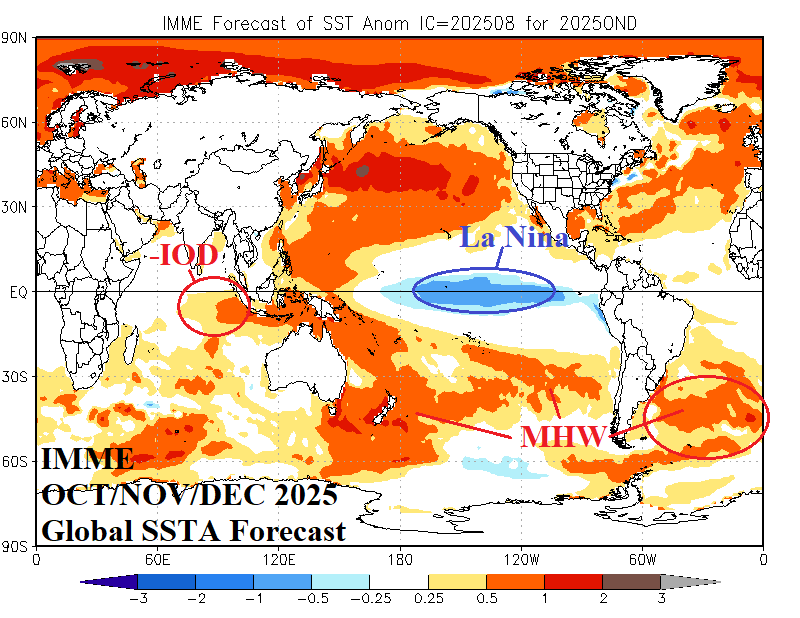
Fig. 6: The IMME global SSTA forecast for Q4/2025.
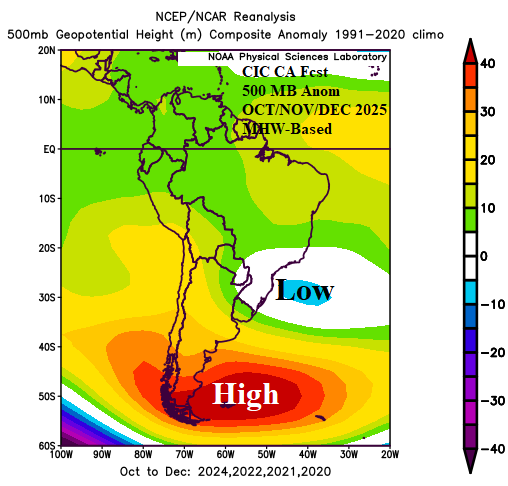
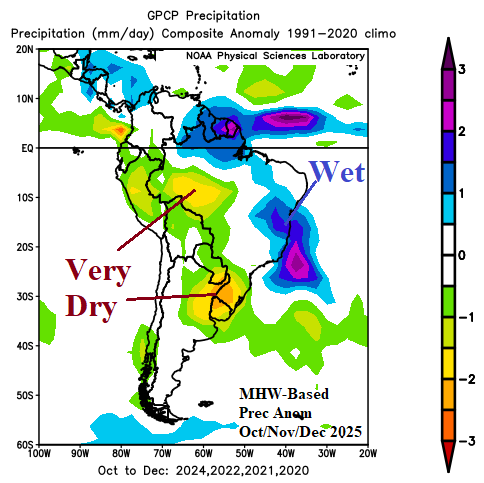
Fig. 7-8: Marine heatwaves east of Argentina in recent years during OCT/NOV/DEC are well-correlated to an upper ridge off the South Argentina Coast causing a dry central South America climate while a compensating trough brings rain to East Brazil.
September 2025: The outlook for early meteorological spring is mostly hotter and drier than normal across Brazil, especially in the Southeast. Wet weather appears over Uruguay and vicinity including Northeast Argentina. Wet weather is also likely over northwestern Brazil. The Brazil drought is worsening.

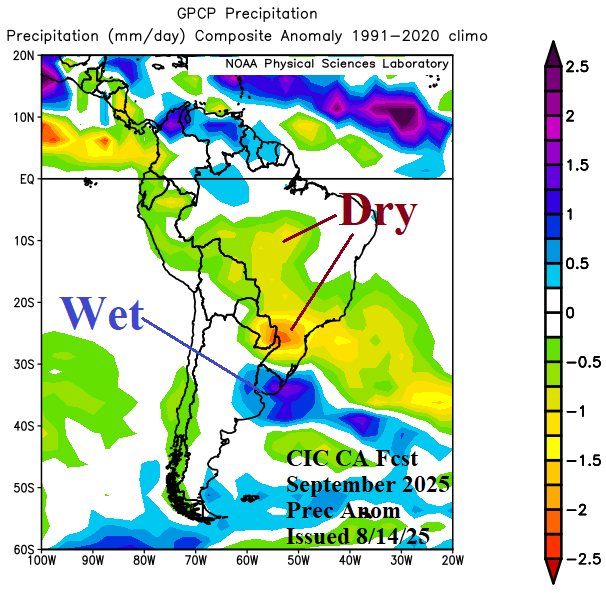
Fig. 9-10: The Climate Impact Company constructed analog temperature and precipitation anomaly forecast for September 2025.
October 2025: Anomalous heat is persistent across the western drought area in Brazil while southeastern Brazil shifts to near normal temperature and rainfall for mid-spring. Eastern Argentina shifts somewhat drier although Argentina avoids significant heat.

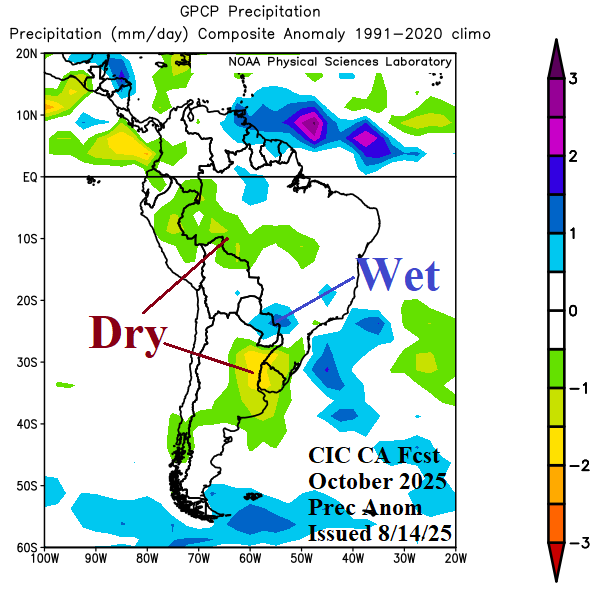
Fig. 11-12: The Climate Impact Company constructed analog temperature and precipitation anomaly forecast for October 2025.
November 2025: Late spring is drier than normal across central continent including Southeast Brazil. Northeast Brazil shifts somewhat wetter. Anomalous heat is projected across Northern Brazil and Central/Northwest Argentina. Drought conditions in Brazil worsen except in the northeast while Argentina drought also strengthens.
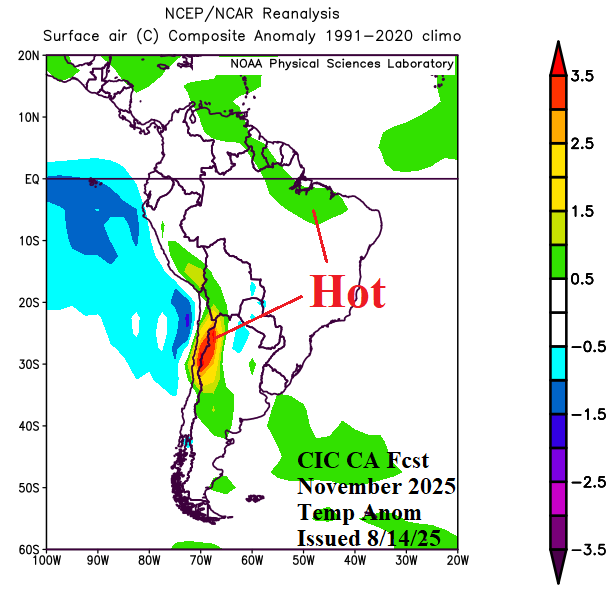
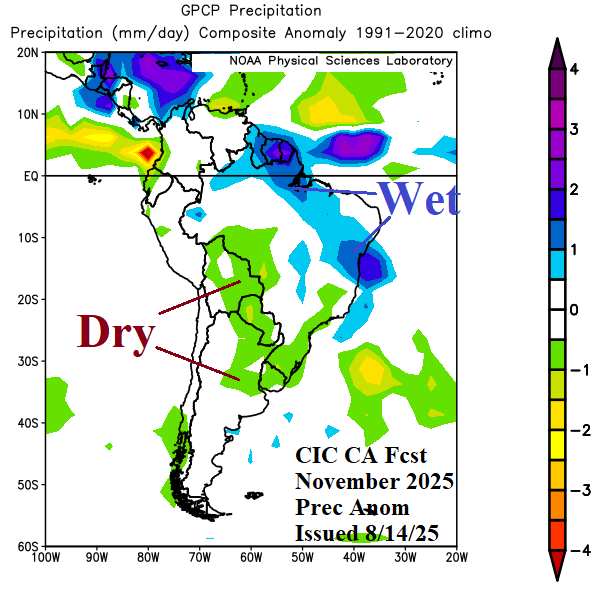
Fig. 13-14: The Climate Impact Company constructed analog temperature and precipitation anomaly forecast for November 2025.
December 2025: As meteorological summer begins, significant rain is forecast across East Brazil. To compensate, influence of an upper ridge dries Argentina to Southeast Brazil and drought in this sector worsens. Argentina anomalous heat helps to accelerate drought.
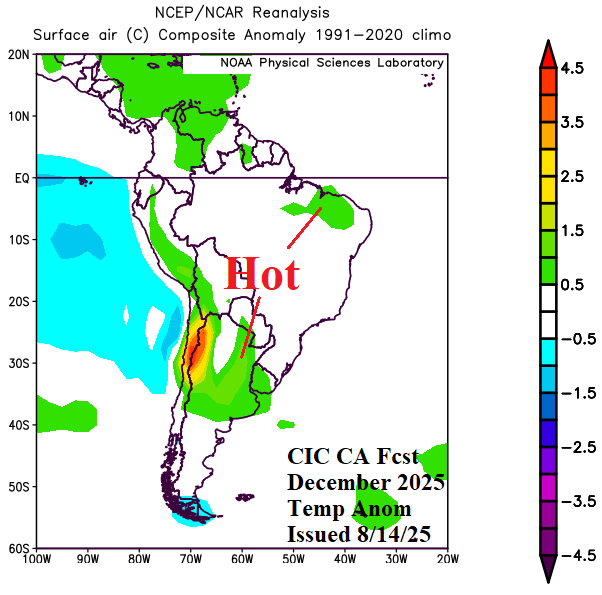
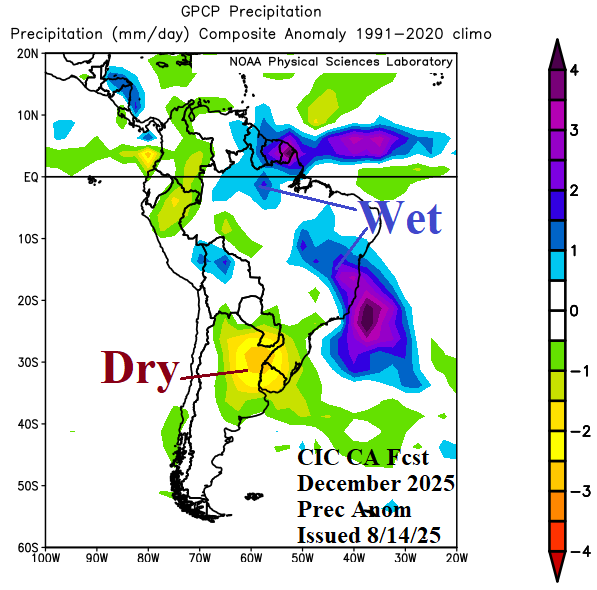
Fig. 15-16: The Climate Impact Company constructed analog temperature and precipitation anomaly forecast for December 2025.
January 2026: The early look at mid-summer indicates a hostile very dry climate across Brazil as drought conditions widen. Bolivia, Paraguay, and Uruguay observe wet climate while Argentina is mostly drier and hotter than normal with drought issues.
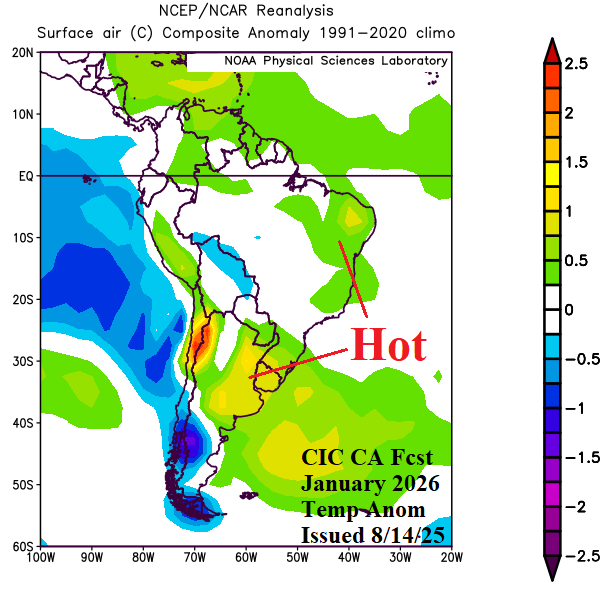
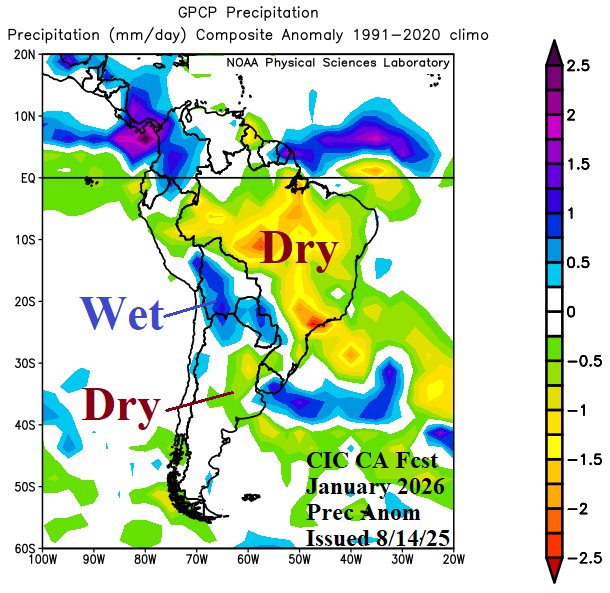
Fig. 17-18: The Climate Impact Company constructed analog temperature and precipitation anomaly forecast for January 2026.

